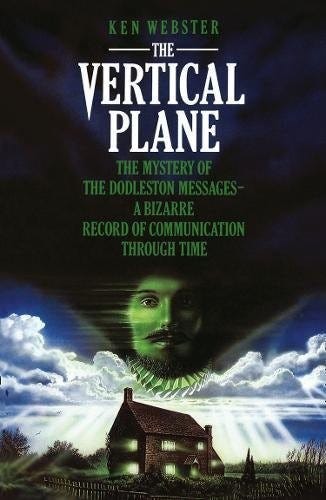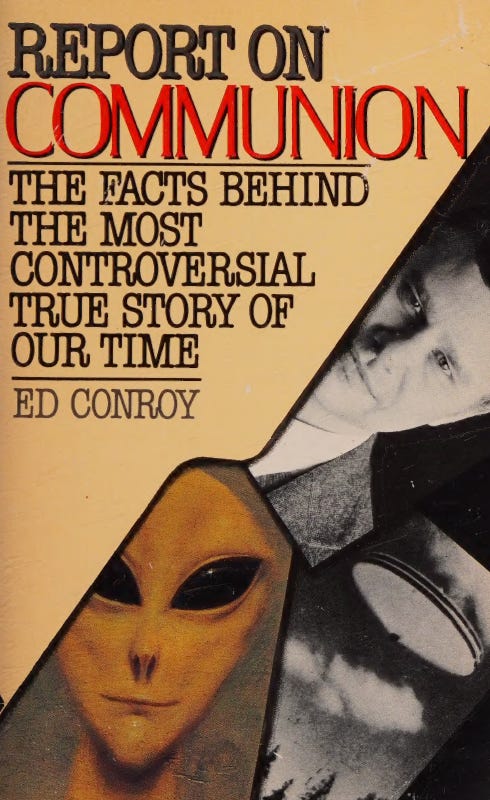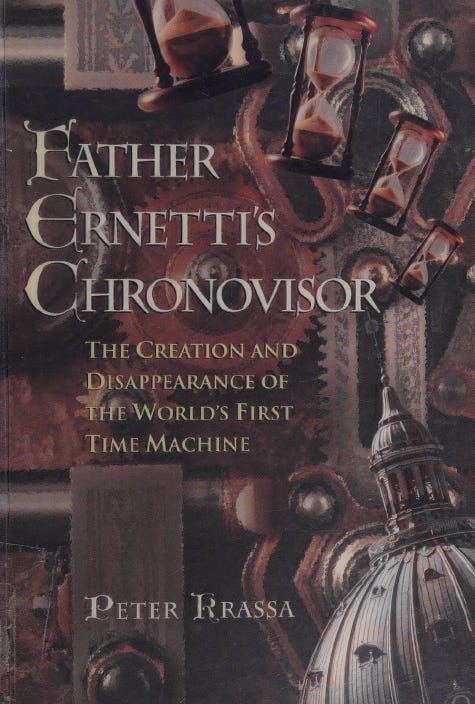The Getting Spooked Reading List #3
Four books to remind readers that I still possess a sense of childlike wonder
Prior reading lists can be found here and here.
As I sometimes feel as though my writing can imply that I am a total disbeliever or a debunker, I feel compelled to once again put forth a short reading list of books that I have greatly enjoyed—even if they require suspending disbelief slightly. While I am highly critical of many aspects of Forteana, ufology, and the paranormal, I know a good read when it’s staring me in the face. The idea for this list originated when I found myself thinking about Malachi Martin, a heavily traditionalist catholic who promoted all manner of far-right Cold War hysteria and hokum. I’ve had his weird anti-NWO papal conspiracist book The Keys of This Blood on a list of article ideas for nearly a year, for instance. But even though Martin’s approach to research, exorcism, and life in general is grounded in the idea that the devil is literally real and a powerfully militant Vatican is the only way to save you, I would be lying if I told you his 1976 book Hostage to the Devil was not a good read. It is a good read, albeit carrying a whole lot of baggage (as is nearly everything in this realm). Presented here are some other books that carry considerably less baggage—still some, of course—but are nevertheless interesting reads. These are books that will keep your childlike wonder alive and well in a world where everyone is an uninteresting Scooby Doo villain or government spook. Don’t ever let the doubters get you down, even if that includes me.
Ken Webster – The Vertical Plane: The Mystery of the Dodleston Messages—A Bizarre Record of Communication through Time (Grafton Books, 1989)
The non-fiction book version of what would be a killer Art Bell call-in show, Ken Webster’s The Vertical Plane is the tale of a mild-mannered teacher from the tiny village of Dodleston who was somehow able to communicate with entities living in different centuries to his own. Through numerous messages typed into a non-internet connected BBC Micro, Webster conducted conversations with a man living in 1546 who saw the computer as a glowing green box and was able to interact with it. Without going into too much detail to avoid spoilers—seriously, I wish I could read it for the first time again—Webster and a motley crew of unlikely paranormal investigators dig for details from their ethereal contact, resulting in some tentative answers but even more intriguing questions. There is poltergeist activity, 1500s drama happening in real time in 1980s Britain, and even stranger contacts from an entity that claims to be from the future, inexplicably speaking in terms one might see in the work of Deepak Chopra. It is all incredibly weird, engagingly written, and accomplishes what has been lost in many modern-day incarnations of paranormal non-fiction works: A truly unique premise buttressed by high strangeness. As is the case with many of purported instances of paranormal phenomena, actual evidence is hard to come by in the case of the Dodleston messages. Even the limited (but exciting) corroboration that arrives in this story comes across as a tad too convenient to accept wholeheartedly. Regardless, I remain staunchly agnostic because this is a great narrative and, as far as I can tell, the story is not doing anyone any harm. What’s the point of debunking an absolute rip-roaring fun time like this book or Mel’s Hole? I am a sucker for a good time travel story, and this is perhaps the best of the bunch. Although “travel” might not be the correct descriptor, it is the subversion or inversion of the genre that makes The Vertical Plane so special.
Simon Young (Editor) – The Fairy Census, vols. 1 & 2 (Self-published, 2018 & 2023)
Stories of fairies and other assorted fae folk are underrated within the Fortean canon, often overshadowed by the omnipresent UFO encounter or alien abduction. That’s not to say that there aren’t similarities, but fairy incidents tend to be a little more whimsical or surreal, with a few horror stories chucked in amongst them. And this is why Simon Young’s huge collections of fairy encounters are legendary, running the full gamut of physical detail, time, and location. Witnesses report seeing tiny humanoids, brownies, gnomes, and fairies in all manner of circumstances, with Young doing the necessary editorial work while still keeping the personality of each entry unique and sincere. As an example from the first volume (although both are chockful of interesting stories):
It was a very brief encounter late one evening. My partner and I had been watching television, and had since switched the TV off and [we] were talking for some time. At one point I glanced towards the area where the television is only fleetingly as one would do while not paying any particular attention, and caught a glimpse of a small gnome-like man. Immediately I looked again but the entity had gone. From the brief glimpse I had I could see it was almost a cross between the classical description of brownies and a gnome. It can’t have been more than six inches tall judging by the furniture I glimpsed it on. It had a scruffy dark brown or black beard which seemed to be spiky and covered most of its face. (…) It left a feeling of being watched, but wasn’t malevolent. It’s just a shame the sighting was so fleeting. It does feel like I’ve glimpsed something that didn’t want to be seen.1
Short but intriguing tales such as this fill up the pages of The Fairy Census and seeing them all laid out together certainly makes one wonder what all these witnesses are seeing. Young has completed some classic, old-school research in the vein of Charles Fort, collecting strange confrontations with the fairy realm and letting the reader bask in the possibility of magic still existing within our world. The only appropriate comparison I can muster is the many volumes of Albert Rosales’ Humanoid Encounters series, which I constantly return to when I am in need of levity. Some chicken soup for the Fortean soul, so to speak.
Ed Conroy – Report on Communion: The Facts Behind the Most Controversial Story of Our Time (Avon Books, 1989)
Nearly everyone is familiar with Whitley Strieber’s Communion, the ship that launched a thousand abductees, but I have seen fewer people remark on a follow-up book that came out shortly after Communion and its sequel Transformation were on store shelves. I have been critical of Strieber’s story in the past, noting the possible parapolitical elements to his experience that get pushed aside in favor of the more metaphysical—or, alternatively, these elements get blended together into a heady stew of nonsense. More recently, in an appearance on The Danny Jones Podcast, Strieber claimed that he applied to become a CIA agent but was told by James Jesus Angleton himself that he was “too patriotic” to join the CIA because it was “full of Russian moles.”2 You’re not going to make it easy for me to recommend a book about you, are you Whitley? All this aside, journalist Ed Conroy’s exploration into Strieber’s background and alien abduction claims is a fascinating time capsule, covering the story while it unfolded as a cultural phenomenon nearly in real time. Strieber had just released the sequel to Communion to a much colder public reception but had not branched out into the more bafflingly mystical and credulous work he would do in the 90s and onward. In the meantime, Conroy investigates multiple facets of Strieber’s story as it was just solidifying itself in the mass consciousness, consulting with Strieber’s relatives, acquaintances, and a variety of “experts” to attempt to come to some understanding of the nature of Strieber’s experiences and whether he was telling the complete truth. Indeed, there are a wide array of cameos from popular personalities in the UFO sphere in the book that do not age especially well—one Linda Moulton Howe comes to mind first. But Report on Communion gives the reader an interesting insight into the UFO landscape of the late 1980s, notably before Bill Moore’s 1989 MUFON speech where he admitted to peddling disinformation on behalf of AFOSI. Moore is even mentioned in an interesting passage:
Strieber attested (…) to the fact that he had visited the Roswell area with Moore and was convinced that it was very likely a crash had occurred, officially making himself a player in the game of an alleged United States government UFO coverup.3
Womp womp. I will avoid spoilers once again so that future readers can savor the investigation, but Conroy winds up finding himself wrapped up in some Strieber-ian high weirdness. True to the paranoia of the era’s UFO scene, black helicopters come into play. Perhaps Strieber’s story began affecting him to the point where the phenomenon started looking back at him—or maybe he was ready to believe all along. I saw that he’s still with the San Antonio press and continues writing favorable UFO-oriented stories. However, Report on Communion is an idiosyncratic work, an in-depth investigation into a UFO abductee with journalistic bent that is often sorely lacking in the present day save for a few thorough debunkings. As someone who thinks every story of this nature—UFO, alien, bigfoot, ghost, or otherwise—deserves this outside-looking-in treatment, Conroy’s book is a satisfying, if slightly naïve, read. A suitable comparison would be the work of George Knapp, because while I wouldn’t trust the content as far as I could throw it, it’s an ultimately pleasurable but cavalier form of “journalism” to ingest.
Peter Krassa – Father Ernetti’s Chronovisor: The Creation and Disappearance of the World’s First Time Machine (New Paradigm Books, 2000)
In a story that would make an excellent double feature with Webster’s The Vertical Plane, German journalist (and Erich Von Däniken biographer *gulp*) Peter Krassa traces the origin of the bizarre “chronovisor” story—a device created by a Vatican priest that could literally see through time. Father Pellegrino Ernetti, who had studied physics and music theory, combined his skills with those of (allegedly) Enrico Fermi, Wernher Von Braun, and others to create a fantastic instrument that used “a multitude of antennae” to “pick up every conceivable wavelength of light and sound” and home in on specific points in time both visibly and audibly.4 Ernetti and his dream team of scientists were able to listen to speeches by Mussolini, Napoleon, and even Jesus Christ, as well as witness the performance of lost plays from classical Greece. Of course, the evidence put forth for these astonishing claims is lacking: Several of the photos recorded with the chronovisor are unconvincing and Ernetti’s purported recovery of the lost Seneca play Thyestes was an embarrassing display—even Krassa was dubious of the latter. Nevertheless, the book explores how the chronovisor and its vaguely explained technological basis fit into a tradition of other “time travel” devices, mesmerism, etheric fields, theosophy, instrumental transcommunication, and even the claims of the aforementioned Whitley Strieber. Krassa is well-versed in the fringe, and although he is perhaps a little too trusting of the chronovisor story, he recognizes that the instrument (if it ever existed) was not solely a scientific achievement, being very much informed by all manner of woo offshoots that preceded and succeeded its short lifespan. The book is a wild trip that treads far afield from Ernetti’s story—but then again, there is not much to go on in Ernetti’s story alone. The chronovisor was allegedly dismantled and explicitly banned by the Vatican who found its power too immense. Sure, that’s a convenient end to the tale of an invention that has no solid evidence backing it but just go along for the ride!
Available here. (Physical copies unbelievably expensive.)
Thank you for reading Getting Spooked. If you’ve enjoyed what you’ve read, consider becoming a regular subscriber to get posts sent to your inbox. Become a paid subscriber to read over a dozen archived posts, listen to members-only podcast episodes, or ask questions to be answered in Q&As. It is the best way to directly support the continuation of this publication. I also started a referral program that rewards archive access to those who share the newsletter with others, so be sure to tell any friends who might find this work interesting. The leaderboard tab is now public if you want the bragging rights of your referral numbers. Thanks to The Anomalist and Daily Grail for linking to this publication’s prior article. Email me at gettingspooked@protonmail.com with any questions, comments, recommendations, leads, or paranormal stories. You can find me on Twitter at @TannerFBoyle1, on Bluesky at @tannerfboyle.bsky.social, or on Instagram at @gettingspooked. Until next time, stay spooked.
Young, Simon (ed). The Fairy Census 2014-2017. Self-published, 2018. Page 31-32. https://www.fairyist.com/wp-content/uploads/2023/12/The-Fairy-Census-2014-2017.pdf.
“Human-Alien Hybrids on Earth: Infamous Abduction Victim Speaks Out | Whitley Strieber.” YouTube, uploaded by Danny Jones, 9 September 2024. (Timestamp 9:35)
Conroy, Ed. Report on Communion: The Facts Behind the Most Controversial True Story of Our Time. New York: Avon Books, 1989. Page 131.
Krassa, Peter. Father Ernetti’s Chronovisor: The Creation and Disappearance of the World’s First Time Machine. Boca Raton: New Paradigm Books, 2000. Page 21.








Some great suggestions in this.I had to grab the fairy book!
"....there are a wide array of cameos from popular personalities in the UFO sphere in the book that do not age especially well—one Linda Moulton Howe comes to mind first...."
I have never seen any IV with LMH that ever aged well....she gets bonus points for being consistently bonkers..
Report on Communion looks like a winner. Nice list thanks for sharing